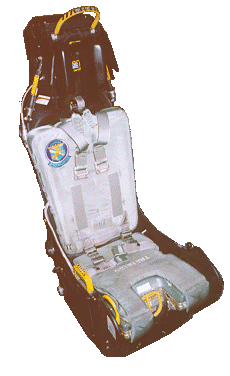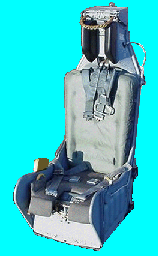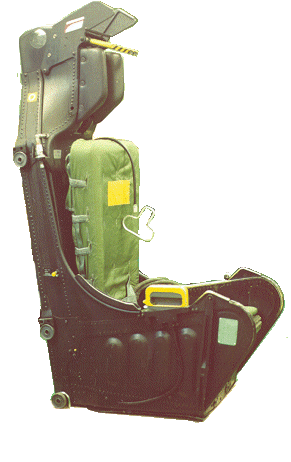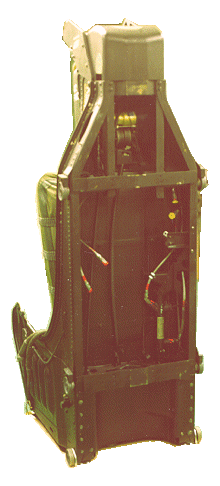The Ejection Site
The Douglas Escapac

The ESCAPAC series of ejection seats by
Douglas Aircraft is one of the most significant American designed/manufactured seats. Escapacs were fitted to many U.S. Navy aircraft including the A-4 Skyhawk, the A-7 Corsair II, and the S-3 Viking. In the USAF inventory, they were used in early F-15 Eagles, and in the YF-16, as well as early A-10 Thunderbolt IIs They have a very good reputation when used in the envelope. There are some 20 variants of the Escapac for the different aircraft, each with a different designation.
The seats are of fairly simple construction as the shell does not have a main beam assembly. The seat is attached to the rails via a set of rollers along the rear sides of the seat. To safety the seat a single handle is pulled out of the center of the headrest (its nickname is the 'headnocker'). This locks both the primary and secondary handles. Safety pins are also used by the ground crew. Most Escapacs have either fixed or mechanically activated canopy breakers to shatter the transparency prior to the crewmans helmet striking it. The parachute pack is a rigid framed pack with an internal delay system actuated by a static line attached to the seat on the right side. This static line is released if the manual harness release handle is pulled. The seatpan survival kit is a hard pack with internal emergency Oxygen bottle. A round hole in the front right of the seat cushion normally provides a view of the gauge to verify it is full prior to flight.

From the Escapac I seat on the Escapac line went through several variations. The earliest seats had the face curtain assembly attached atop the headrest. The Escapac IA-1 version (photo right) was used in the A-4E Skyhawk. The seat firing handle is also noteworthy as it is a metal unit as opposed to the later rubber handle. This seat is incorrectly rigged with a USAF survival kit and cushion as well as the USAF male riser connectors. The Skyhawk used several different Escapacs over the years and each of the seats was an improved version of the prior version. Some other changes involved the catapult and rocket, the parachute, as well as canopy breakers and jettison systems.
Designation Aircraft
1 A-4A, B, C, & E
1A-1 A-4A, B, C, & E
IC-2 A-7
IC-3 A-4F, TA-4F, and SUBS
IC-6 B-57 & RB-57 Series
IC-7 F-15A, TF-15A
IE-1 S-3A
IE-2 A-9A
IF-3 A-4F & TA-4
IG-2 A-7
IG-3 A-4F, TA-4F & SUBS
IH-8 YF-16A
IE-9 A-10A
IG-4 TA-7 (Front)
IG-5 TA-7 (Aft)
IG-7 F-15A, TF-15A
IC F-111A, F-111B,
XV-5A (back-up), XV-4A, XC-142A,
OV-10A, CL-84
and "Charger"
ID X-22A, and XV-4B
Seat constructions among all the Escapacs is very similar with the primary difference in all the later seats being the width of the seat pan. One of the main equipment differences from version to version mainly involved the seat separation system. The earlier seats used a bladder system with a nitrogen bottle to push from behind the parachute pack, and under the survival kit at separation. Later seats were equipped with a Mk. 82 seat separation rocket. This rocket located on the left shoulder area (photos here show the oval slot for it) vectored its thrust up and forward imparting a rearward rotation of the seat away from the aircrew. The proximity to the aircrew's head led to the nickname 'Earburner' for this rocket, however it was quite safe in practice.
Earlier Escapacs had no seat stabilization system provided, but that changed with the addition of the DART system. DART is a lanyard attached to the cockpit floor and fed through a series of roller brakes on the bottom of the ejection seat to keep the seat from tumbling after ejection. At the end of the lanyard (about 20-30ft) the lanyard unspools off the roller brakes and the seat flys free. The DART system has been used on several types of seats including the
F-100D seat. The very late Escapacs such as the ones used in the S-3 Viking were equipped with an active stabilizer rocket, the STAPAC system. This system was later used as standard equipment on the
ACES II seat.
The rails in aircraft such as the S-3 Viking are angled to provide
separation of the ejected man/seat packages. This is to prevent collisions which could cause injury or prevent seat function.
These pictures show an Escapac IG-4 from the front seat of an TA-7C. The NES-12 parachute pack is a rebuilt one. The greenish tint of the photos is due to flourecent lighting at the site where the photos were taken. The above Escapac IG-2 (A-7D) is closer to the correct colors, but the sage green has washed out a little.
Escapac IG-2 in gray
front view From
Chris's Collection
Escapac IA-1
Right side Courtesy R. Chad LeBeau of Aviation Artifacts
RSSK-8E Front
RSSK-8E Top/Side Typical USN Survival kit for an Escapac
NES-12 Parachute pack Parachute pack used on many Escapacs. The lumbar pad
and mesh mount indicate this was probably from an S-3A.


Voy a hablar por boca de jarro...y tirar una teoría loca basándome en un esquema de la explicación del cambio de forma y posición de la sonda de repostaje de los Tornado, de enciclopedia "El mundo de la Aviacion" asi que voy a sugerir o suponer que la naris/radomo mas larg@ y cónica inclinada de los E, pudiera generar alguna corrientes de aire/turbulencias que aleja o mueve la canasta al momento de conectar con el cisterna...y a diferencias de la naris/radome del las A/B que era extremadamente aerodinamica (con forma como de bala) en donde la sonda recta asumo no aparejaría problemas?








